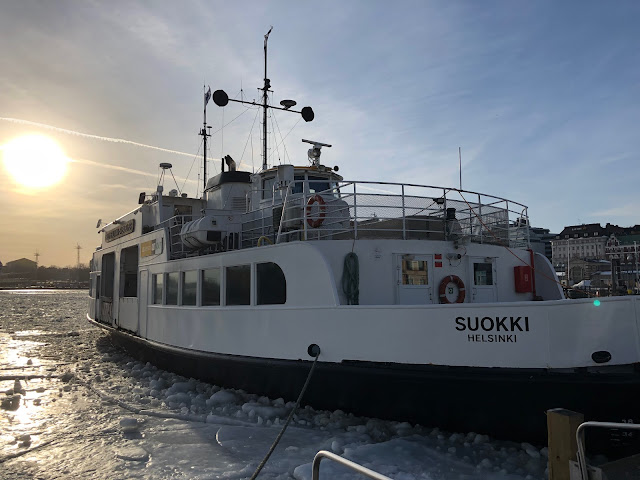Side Trips: Helsinki
 |
| An ice breaking ferry, Port of Helsinki |
We went to Helsinki with only three Finnish words between us: terve (hello), anteeksi (excuse me) and kiitos (thank you). This did not matter in the slightest because every Finn we encountered was proficient in English to a degree that made me question whether it was an official language (it is not; those would be Finnish and Swedish). The accent of a French person speaking English typically sounds like they did their best late in life to learn a very dissimilar language, with a different syntax and a presumed indifference to pronunciation. I can understand their English about as well as they can understand my French, so we can at least take care of business at the marché or boulangerie.
Finns speaking English sounded like they had moved to US in grade school, became organically fluent, but still retained enough of an accent to make an American wonder where their parents came from. The first Finnish stranger we encountered in a coffee shop called Finca las Ventanas (roughly "the windows estate" in English from the Spanish, ikkunoiden kiinteistö in Finnish) was eager to discuss Joe Montana's 1980s glory days with the 49ers. He had two English language paperbacks with him. I know this because he asked to sit with us while we enjoyed our Colombian coffee, bearing out Finland's reputation as both friendly and coffee-mad.
English proficiency makes perfect sense for Finland. With fewer than 6 million people, a small, though advanced, economy (Finland's GDP in 2022 was $280 billion, ranking it 59th worldwide, just behind Ethiopia), and a non-Indo-European language with few linguistic correlates outside of the Baltic Region, relying on Finnish or Swedish alone would likely have left Finland an economic and geopolitical backwater after it shook off off both Nazi and Soviet influence at the end of WWII. Instead, it's a modern, cosmopolitan country, fully integrated into the EU, the Eurozone, the WTO and OECD economic partnerships and, since last year, NATO.
English was so prevalent in Helsinki that we made our way around as easily as if we were back in any city in the US--more easily in fact, given the extent and frequency of their light rail trains. That was just one of the city's touches that made it seem distinctly Finnish. The public sauna that allowed overheated bathers to plunge into an inlet of the icy gulf of Finland from an open area of the dock was another.
The historic architecture around the town also had unique features. The buildings in the downtown area are principally from the late 19th century, with a mix of Empire, neo-gothic, Victorian and modernist styles. But again, these have a Finnish flair, both in the materials--lots of brick and a local red granites--and with design elements. For example, the copper clock tower of the Helsinki Central Railway Station, designed by Finnish architect Eliel Saarinen in 1914, is one of the earliest examples of Art Deco architecture, completed more than a decade before the 1925 Exposition internationale des arts décoratifs et industriels modernes (International Exhibition of Modern Decorative and Industrial Arts) in Paris.


Nearest to my heart, however, were the many mascarons and bas-reliefs representing Finnish folklore and wildlife. Bears, owls, wolves, squirrels, and dogs supplanted most of the lions typically seen on French buildings, joined by assorted witches, goblins, and trolls. The prime example is the 1901 neo-gothic Pohjola Insurance building (also created by Eliel Saarinen). The word Pohjola itself refers to a place in Finnish mythology as detailed in the 19th century compilation of epic poems, Kalevala. Fittingly, the building's ornamentation evokes Jim Henson's Monster Shop, with wild beasts and ghastly faces installed as reminders of the idiots, scary monsters and supercreeps that await to wreak havoc on your home or business--and against which you can indemnify yourself with a comprehensive insurance policy.
 |
| Pohjola Insurance façade (above), with various risk-assessed hazards below. |












Comments
Post a Comment